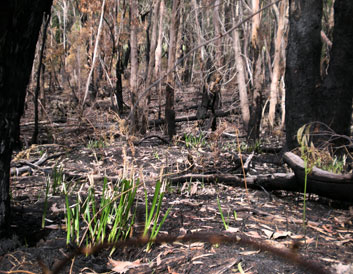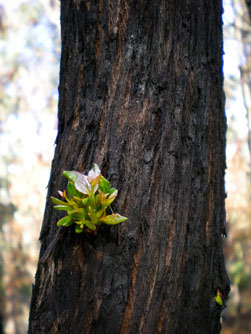 |
Back to Factsheets | Download PDF
Australian Forests and Fire Regeneration
Fire adaptability in Forest Species
Researchers still do not know exactly when fire-adapted plants first appeared in Australia. Fossil and charcoal records show that over the last 700,000 years there were alternating periods of dry to wet eras. At times when high rainfall dominated many parts of Australia, the vegetation was dominated by temperate and tropical rainforests, as well as many Casuarina species (she oaks) which are relatively fire sensitive. During the drier periods, fire tolerant plants, such as Eucalypts dominated and the rainforest plants maintained a foothold only in the valleys and gullies in south and eastern Australia. In the southern states, the Myrtle Beech (Nothofagus cunninghamii) was the main species to decline when a drier climate evolved. Whereas in the north of Australia, Bunya Pine (Araucaria bidwilli) and Hoop Pine (A. cunninghamii) lost their stronghold to the highly adapted Eucalypts and other Myrtaceae species.
Eucalypts are extremely specialised plants. They have evolved to such an extent that not only can they survive a fire but they can actually cultivate a fire to suit their needs.
Listed below are ways in which fire-tolerant Eucalypts have adapted to a hot dry climate with periodic fires:
1) fine leaves which burn fast and intensely;
2) highly flammable oil content of leaves and twigs;
3) heavy litterfall (leaves, bark, twigs, and branches) in the drier months providing a ready supply of kindling;
4) open canopies of hanging foliage which encourage up draughts during fire;
5) two types of bark, both of which assist in the spreading of fires. The "ribbon" type bark hangs in the trees which will assist the fire upwards into the crown. The "stringybark" provides deep crevices for embers to grip to and stay lit;
6) as the trees burn the seed is dispersed from the hard woody capsules which have opened with the heat of the fire.
7) epicormic (beneath the bark) buds and lignotubers (suckering stems from the roots) enable the gums to grow new leaves and branches within weeks of the fire. A thick insulating bark assists these buds to survive the fires heat.
 |
Nature out of balance
Early Europeans described Australia's bushland as almost parklike where bullock drays could be driven just about anywhere because of the lack of scrub growing under the towering gums. We now know that this wasn't by accident. Australia's aborigines had been burning the bush and grasslands for tens of thousands of years. These fires, mostly mild, burnt the understorey and maintained the canopy. Sun loving and fire tolerant pioneer species could not colonise the forest . With the colonisation of Australia by European settlers a completely new way of dealing with the bush took place.
With the killing of Aborigines and the advent of European farming practices, the traditional mild burns which would take place every few years, stopped. Europeans didn't use fire to their advantage like the Aborigines did. So fire became less frequent and as the forest floor accumulated more and more litter the fires that did start were very intense. These wildfires changed the types of vegetation in these forests. With the canopy now open, sun loving and fire tolerant understorey species moved in. And thus what we see today is very different from the bush of 200 years ago.
Some of the genera included in this list are:
1) Leptospermum (teatree)
2) Cassinia (dogwood)
3) Pteridium (brackenfern)
4) Acacia (wattles)
5) Epacris (heath)
6) Xanthorrhoea (grasstree)
 |
What happens in the bush after an intense fire
A whole series of related evolutionary activities start to work overtime once a bushfire has gone through a sclerophyll forest (a forest dominated by fire tolerant eucalypts). The forest floor is now layered with a fine bed of nutrient rich ash, which also has a structure to make the perfect seed bed. The overstorey of eucalypts has dispersed its seed when the heat from the fire opened the seed capsules. Other genera of plants have also evolved with fire and have specialised ways of regenerating themselves or their offspring. Members of the myrtaceae family (of which eucalyptus is the main genus) also have woody seed capsules which mostly retain the seed for many years.
Some of these are:
1) Leptospermum (teatree)
2) Kunzea
5) Calytrix (fringe myrtle)
2) Callistemon (bottlebrush)
4)Melaleuca (honey-myrtle, paperbark)
6) Baeckea
However, out of all the fire loving plants the Acacia (wattle) genus seems to have benefited mostly by the spread of uncontrolled fire. The wattles annually drop their seed (which has an extremely hard seed coat, is water resistant and long living) which accumulates in the leaf litter over many years. The seed coat cracks open after the fire has gone through. As the autumn rains add moisture to the ash seed bed, literally thousands of wattle seeds germinate every square metre. And as the seasons come and go the fastest growing of these seedlings out compete their smaller counterparts and develop into an impenetrable mass of saplings all stretching to the sun.
While the wattles (and other members of the Leguminous families ie., Pultanaea, Dillwynia, Daviesia- all "egg and bacon" plants and Indigofera, etc.) are growing, many other flowering species are also using the sunshine to reproduce themselves. These species grow in abundance and because of their lovely flowers attract many a bushwalker with camera in hand. Some of these plant species include: Epacris (common heath), Kennedia (running postman), Helichrysum (everlasting daisy), various orchids, Brunonia (blue pincushion), Astroloma (cranberry heath).
Some of the gums (especially older, unhealthy specimens) die in fires. These individuals though, are still very important in the forest ecosystem. The younger trees coming up underneath the old "stags" are a ready food source for many faunal species (insect, bird and mammal) but it's these hollowed out trees that provide safe nesting sites where the animals can live. One such example is the endangered Leadbeater's Possum which only lives in the hollows of Mountain Ash (Eucalyptus regnans) trees and one of its main food sources is young Mountain Ash seedlings. Obviously this, and other possums are highly dependant upon fire for their survival. Once the Eucalyptus canopy closes in (anywhere from 5-25 years) the sun loving pioneers die off (except for some of the quickest specimens of the taller species ie., Acacia mearnsii - Black Wattle, A. dealbata - Silver Wattle, A. melanoxylon - Blackwood). The smaller, weaker specimens fall down and rot away. But their job is finished. There is enough wattle seed stored in the leaf litter to repopulate their species after the next fire.
It usually takes a number of years before shade loving understorey plants become noticeable. Some specimens would have germinated after the fire and struggled through the hot summers to come without a canopy. Some seed would have blown in on the wind in subsequent years after the fire and taken a foothold then. These species tend to be longer lived than the fire loving plants but are much less tolerant of fire and direct sun. They have large, soft leaves; no dormant buds ready to grow after a fire; their seed is highly perishable and thus doesn't store well in the leaf litter.
Some of the species included here are:
1) Olearias (native daisy bush)
2) Bedfordia (blanket leaf)
3) Pittosporum (banyalla)
4) Pomaderris (hazel pomaderris)
5) Coprosma (currant bush)
6) Lomatia (forest lomatia)
7) Hedycarya (austral mulberry)
8) Pimelea (rice flower)
9) Phebalium (satinbox)
As the years pass young Eucalypt seedlings become trees and the forest becomes a climax community. In other words, the succession of different plant species occupying the same forest over time slows then stops......until the next fire!
Mike Robinson-Koss, Otway Greening Nursery, Deans Marsh Victoria, 1998
References 1) Costerman, L., 'Native Trees & Shrubs of SE Australia', Weldon,1981 2) Webster, J., 'Complete Australian Bushfire Book', Nelson, 1986 3) White, M., 'The Flowers of Anglesea River Valley', Self published, 1989 4) Zola, N., and Gott, B., 'Koorie Plants Koorie People', The Koorie Heritage Trust, 1992
|











